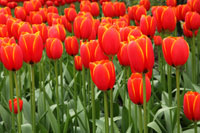 
Tulip Facts for Kids
Check out our fun tulip facts for kids. Learn how many species of tulip there are, how the tulip has been used throughout history, find out what "tulip mania" is, and much more. | | |
The word tulip is derived from a Persian word called delband, which means turban. It is generally believed that it was called this due to the turban-shaped nature of the flower. However, this might have been a translation error as it was fashionable to wear tulips on turbans at the time.
The Dutch obsession with tulips began with Flemish botanist Carolus Clusius. When he was made director of Leiden University's new Hortus Botanicus (botanical garden) in 1593 he planted some of his own tulip bulbs. As a result, 1594 is considered the official date of tulips first blooming in Holland.
This led to a period from 1634 to 1637 known as "Tulip mania" when enthusiasm for the new flower started an economic frenzy and one of the world's first 'speculative bubbles'. The value of tulips shot up nearly overnight, they became the most expensive flower in the world, so expensive that they were treated as a form of currency.
Today, the Netherlands is still the world's main producer of commercially sold tulips, producing as many as 3 billion bulbs annually, mostly for export.
Tulip petals are actually able to be eaten, during the Dutch famine of 1944 in WWII people often had to resort to eating sugar beets and tulips. The tulip is the national flower or Turkey and Afghanistan.
| | |  | | More Plant Facts: | | | | | | Tulip Facts |
|
|